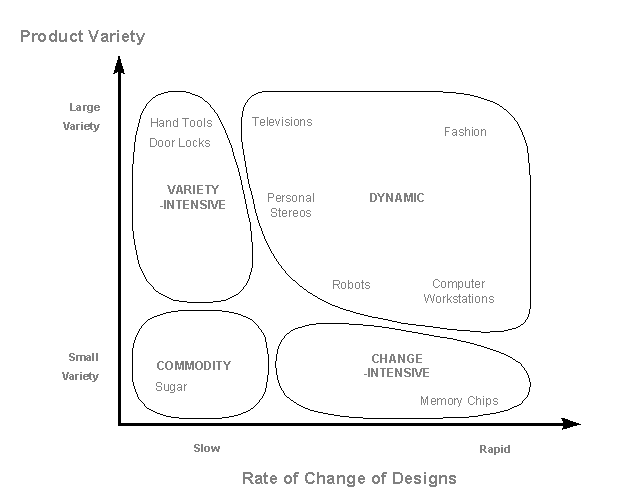
Copyright 1995, Mustafa Uzumeri,
uzumeri@business.auburn.edu
Note: This page is based on the paper: "A framework
for model and product family competition", Mustafa Uzumeri
and Susan Sanderson, Research Policy 24 (1995) 583-607.
Additional
papers can be found in my
publication list.
A book elaborating the competitive implications of this typology
is currently in preparation.
One of the most difficult tasks in studying competition among products is the challenge of comparing competitive behavior across different types of products. It is very difficult to relate competitive strategies when the technologies, products, distribution mechanisms and customers are totally different. At the same time, there is a gnawing sense that certain useful similarities must exist in the way firms approach the challenge of dealing with their product lines.
This stream of research was inspired by the belief that "omnidimensional" measures might provide a fruitful avenue of attack on this problem. These are measures that can be applied to any unit of analysis. In this case, a typology was constructed that juxtaposed variety of product designs against the rate of serial change of product designs. This forms a "map" of product competition that has four distinct regions:

Commodities are products where the rate of serial design change is very slow and where product variety is extremely low. Stereotypical commodities included sugar and minerals.
Traditionally, competition among commodity products has focused on factors other than innovation. The most common methods for differentiating commodities are price, delivery and level of service. With a commodity, a company can incrementally perfect its policies and procedures over an extended period. With neither design change nor variety to worry about, these companies face fierce competition, but not a great deal of product complexity.
Historically, US companies have been very competent at this type of competition. The formal, hierarchical management structures typical of many large postwar US manufacturers provided the centralized control that enabled firms to maintain tight control over profit margins. Fortunately, the inherent rigidity of these structures was not a liability, given the fact that the product itself changed seldom, if at all.
Increasingly, however, even the simplest products are becoming more complicated, as the following examples from the beer and petroleum industries illustrate. In particular, it is apparent that even as the product remains the same, the potential uses of these "commodities" are proliferating just like all other products.
With change-intensive products, companies are under relentless pressure to produce the next generation of "newer and better" product design. The extreme cases of this type of competition can be seen in the software and semiconductor industries. When Microsoft introduces Windows 95, it both hopes and expects that the new design will replace its previous operating systems. Similar expectations apply to Micron Technology's memory chips, to Intel's microprocessors, and to Novell's Netware. Put simply, makers of change-intensive products are in a never-ending race, in which companies play by a set of strict rules:
Variety-intensive products are relatively common and are distinguished by the following features:
Examples of this type of firm include American Standard , which makes a host of products, including faucets and plumbing fixtures. An especially good example is Rubbermaid, which makes all manner of molded plastic products. Many of the product lines of 3M, which makes more than 60,000 products in all, are inherently variety intensive
This is not to say that variety intensive manufacturers don't put a lot of effort into innovation. They do. However, virtually all of their new designs are variants on existing models and are designed to extend the product family rather than renew it.
Dynamic products are distinguished by the interactions between product variety and rapid serial change. The following map illustrates the new set of challenges that are uniquely present in this region.

When variety and rate of change interact, companies now must deal with changing varieties, multiple rates of design change at the same time, large variations in the rates of design change, changes that are accelerating or decelerating at different rates and a greater disparity in the magnitudes of the differences between products and over time.
These new challenges are not tied to any specific product or technology. Rather, they are an artifact of the underlying structural pattern of innovation. As such, the term "dynamic product competition" can be applied to any product where the interaction terms are present in significant amounts.
It is this insight that makes the variety change framework so intriguing.
The dynamic region is becoming increasingly important as competitive pressures thrust more products into the realm of interacting variety and change. The forces that are pushing firms include:
As a result, the Web is full of examples of well-known companies such as Microsoft, General Motors, General Electric, and Motorola that routinely operate under conditions of dynamic product competition. At the same time, there are an increasing number of much smaller firms that are facing the same challenge:
All of these companies, both large and small, must find ways to simultaneously manage large variety and rapid change.

This research is being conducted jointly with Susan Sanderson, a colleague at Rensselaer Polytechnic Institute's Lally School of Management.